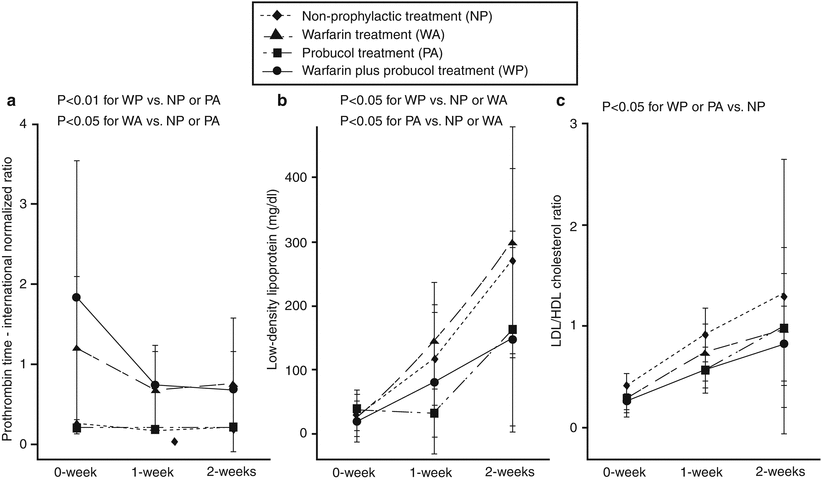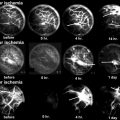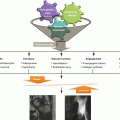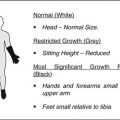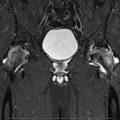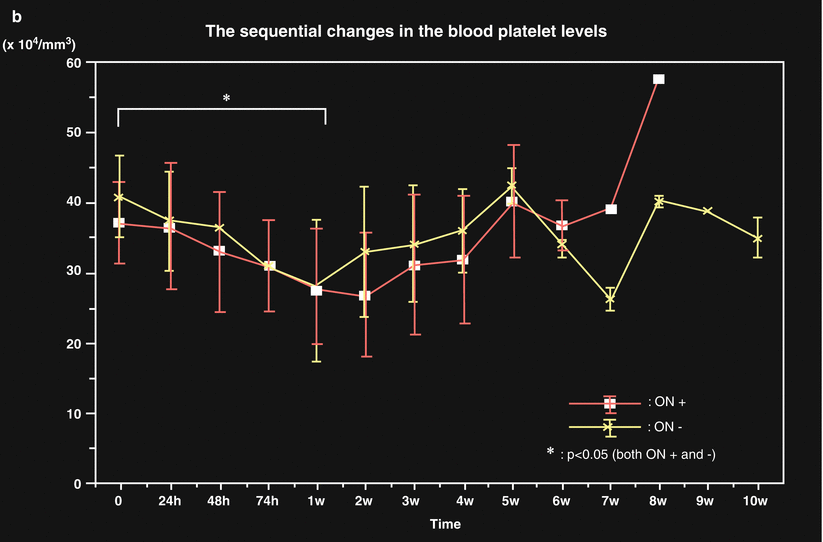
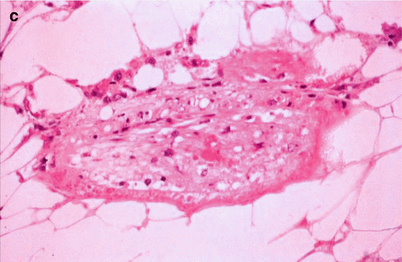
Fig. 33.1
(a) The macroscopical appearance of ON in the femur and humerus 4 weeks after corticosteroid injection. The yellowish-colored areas (arrows) mainly located in the metaphysis represent osteonecrosis area. (b) The sequential changes in the blood platelet levels. Although there was no significant difference between the rabbits with ON (ON+) and those without ON (ON−), the blood platelet levels significantly decreased 1 week after the injection of MPSL (p < 0.05) and then gradually recovered and reached almost a normal level after 5 weeks. ON osteonecrosis. (c) Morphological changes in the vessels of the femur 4 weeks after corticosteroid injection. An organizing thrombus is seen in the intraosseous arteriole, which is accompanied with fibrinous exudate in its wall, just adjacent to the ON in the metaphysis (hematoxylin and eosin, ×200) (Permission from Yamamoto et al. [5])
Based on this animal model for ON, several investigations for the prevention of ON has recently been reported [6–9].
33.2 Combined Effects of Warfarin and Lipid-Lowering Agent [6]
In 2004, combined effects of warfarin and lipid-lowering agent (probucol) on the prevention of corticosteroid-induced ON have been proposed for the prevention of corticosteroid-induced ON [6].
Male adult Japanese white rabbits were injected once intramuscularly with 20 mg/kg of methylprednisolone acetate (MPSL) into the right gluteus medius muscle. These rabbits were divided into four groups, (1) warfarin plus probucol (WP group, n = 25), (2) probucol alone (PA group, n = 30), (3) warfarin alone (WA group, n = 26), or (4) no treatment (non-prophylactic (NP) group, n = 20). Both the femora and humeri were histopathologically examined for the presence of ON 2 weeks after the MPSL injection and hematological examinations before and after steroid injection were performed.
The incidence of ON in the WP group (5 %) was significantly lower than that observed in the NP group (70 %) (p < 0.0001). While the incidences of ON in the PA and WA groups (37 and 33 %, respectively) were also significantly lower than that seen in the NP group (p < 0.05), they were significantly higher than that in the WP group (p < 0.01 and p < 0.05, respectively) (Fig. 33.2).
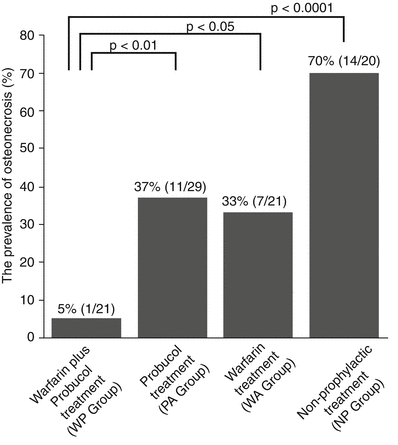

Fig. 33.2
The incidence of osteonecrosis (ON) in the warfarin plus probucol treatment group (WP group, 5 %) was significantly lower than that seen in the non-prophylactic treatment group (NP group, 70 %) (p < 0.0001). While the incidence of ON in the probucol treatment group (PA group, 37 %) and the warfarin treatment group (WA group, 33 %) was significantly lower than that observed in the NP group (p < 0.05), these levels are significantly higher than those seen in the WP group (p < 0.01 and p < 0.05, respectively) (Reproduced from Motomura et al. [6])
The levels of PT-INR in both the WP and WA groups were significantly higher (p < 0.01, p < 0.05, respectively) than those observed in either the NP or PA group throughout the experimental period (Fig. 33.3a). The LDL levels in the WP group remained at significantly lower levels at all the time points tested than those seen in the NP and WA groups (p < 0.05, Fig. 33.3b). The PA group showed significantly lower LDL levels during the study than the NP or WA groups (p < 0.05, Fig. 33.3a). The plasma LDL/HDL cholesterol ratios were significantly lower in the WP group than those in the NP group at all of the time points tested (p < 0.05). The LDL/HDL cholesterol ratios observed in the PA group were also significantly lower than those in the NP group (p < 0.05) at every time point (Fig. 33.3c). There were no significant differences in plasma lipid levels (LDL, VLDL, triglyceride, and LDL/HDL cholesterol) between the WP and PA groups (Fig. 33.3a, b).
